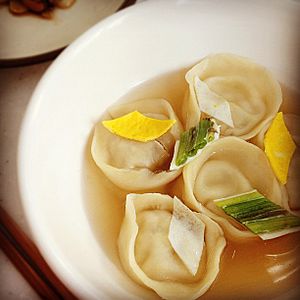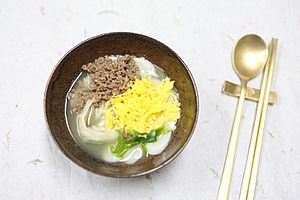Mandu-guk facts for kids
 |
|
| Alternative names | Dumpling soup |
|---|---|
| Type | Guk |
| Place of origin | Korea |
| Main ingredients | Mandu |
| 88 kcal (368 kJ) | |
| Korean name | |
| Hangul |
만두국
|
|---|---|
| Hanja |
饅頭-
|
| Revised Romanization | mandu(-t)-guk |
| McCune–Reischauer | mandu(-t)-kuk |
| IPA | [man.du(t̚).k͈uk̚] |
Mandu-guk (만두국), or dumpling soup, is a popular Korean dish. It is a type of Korean soup known as guk. This warm and delicious soup is made by boiling mandu (dumplings) in a tasty broth. The broth is often made from beef or anchovies. Sometimes, beaten egg is added to the soup as well.
A Look Back: History of Mandu-guk
Dumplings, or mandu, have been eaten in Korea for a very long time. Old records from the 14th century, found in a book called Goryeosa, show that mandu first came to Korea from Central Asia. This happened during the Goryeo era.
In the past, mandu had different names. Until the middle of the Joseon Dynasty, they were called sanghwa or gyoja. Mandu became a special food in the northern parts of Korea, like the Pyongan and Hamgyong regions. This is because wheat and buckwheat, which are used to make flour for the dumplings, grew well there.
People made and cooked mandu in many ways, including manduguk. In the Korean royal court, this dumpling soup was called byeongsi. In an old Joseon Dynasty cookbook called Eumsik dimibang, it was known as "seokryutang". We don't know exactly when manduguk got its current name.
How Mandu-guk is Made
To make the dumplings for Mandu-guk, thin circles of dough are rolled out. These circles are then folded into a half-moon shape. They are filled with a mix of minced meat, fresh vegetables, tofu, and sometimes kimchi.
Once the dumplings are ready, they are boiled in a special broth. Traditionally, this broth is made by boiling anchovies, stems from shiitake mushrooms, and onions. This gives the soup a rich flavor.
Some people prefer to make the broth using beef stock instead. Another common addition to Mandu-guk is tteok, which are cylindrical rice cakes. When tteok is added, the dish is called tteok-mandu-guk.
See also
 In Spanish: Manduguk para niños
In Spanish: Manduguk para niños


